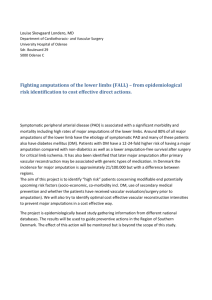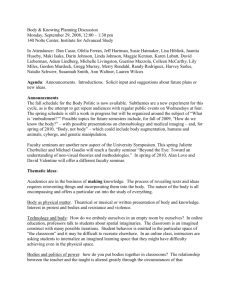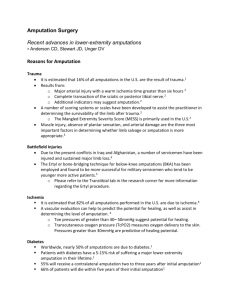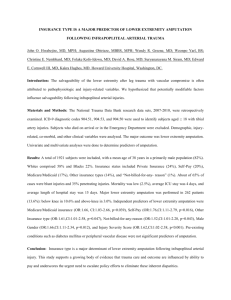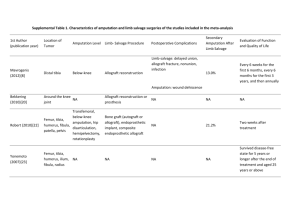AMPUTATIONS
advertisement
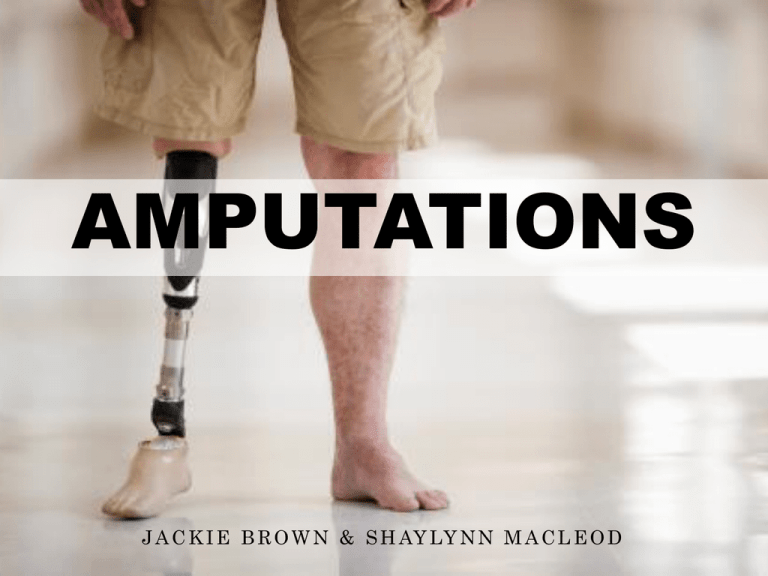
AMPUTATIONS J A C K I E B R O W N & S H AY LY N N M A C L E O D Objectives • To explore related definitions and statistics, causes, and types of amputations • To learn preoperative and postoperative nursing interventions • To discuss possible complications and their prevention • To learn about wound care, including Figure 8 wrapping • To explore care of the residual limb and types of prostheses • To learn about the rehabilitation process for an amputee • To formulate nursing diagnoses relevant to the nursing care of a client with an amputation • To engage critical thinking skills through a case study Statistics 185,000 amputations in the US each year Around 80% of amputees are over the age of 65 80-90% of amputations are caused by PVD Lower extremity amputation (LEA) = 87% of all amputations performed in the US and Europe ↑↑ complications in LEA for disease-related causes with 50% dying within 5 years of LEA Definitions: Amputation –removal of part of the body, limb, or part of a limb Stump – Aka residual limb; part of a limb that remains after amputation Purpose: Relieve symptoms Improve function Improve QOL Save life! Reasons for Amputations Traumatic injury Progressive arterial disease: often a sequelae of diabetes Gangrene/infection Congenital deformities Chronic osteomyelitis Malignant tumor Traumatic Injury Can be complete amputation from an accident Or partial laceration requiring surgical amputation Progressive Arterial Disease Often due to Diabetes Can lead to ulcers that may require amputation Amputation is four times more likely in diabetics than non-diabetics Gangrene May require staged amputations Initially a guillotine amputation is done to remove the necrotic and infected tissue Sepsis is treated with systemic antibiotics After the infection is controlled and the patient’s condition has been stabilized, a definitive amputation with skin closure is performed Prevention Diagnosis and management of diabetes Thorough foot exam once per year Drive safely: Wear your seatbelt Drive the speed limit Safety at work if using heavy equipment, saws, explosives, or flammable substances Sites for Amputation Upper limb: Lower limb: Forequarter: Shoulder disarticulation Hemipelvectomy Above-Elbow: Transhumeral Above-knee: Trans-femoral Elbow disarticulation Below-knee: trans-tibial Below-Elbow :Trans-radial Hand and wrist disarticulation Partial hand: Trans-carpal Hip disarticulation Knee disarticulation Ankle disarticulation Symes (Modified ankle disarticulation) Partial foot Digits Types of Amputations Determined by two factors: Adequacy of circulation Functional usefulness such as requirements to use a prosthesis Objective is to conserve as much extremity length as possible. Preservation of elbow and knee joints are desired Below knee amputations are preferred to above the knee Preop Interventions Assess: Neurovascular and functional status of extremity In traumatic amputation – function and condition of residual limb, circulatory status and function of unaffected limb Nutritional status – healing = ↑ protein & vitamin requirements Psychological status – determine emotional reaction to amputation Current medications – especially corticosteroids, anticoagulants, vasoconstrictors, vasodilators Preop Interventions Identify & address concurrent health problems Dehydration, anemia, cardiac insufficiency, chronic respiratory problems, diabetes mellitus Treat so that client is in best possible condition for surgery X-rays of extremity in 2 views Doppler or angiography to determine perfusion Prepare for client for surgery: Postop expectations Psychological preparation Amputation of Right Leg Postop Interventions 1.Pain relief 2.Altered sensory perception 3.Wound care 4.Accepting altered body image 5.Resolving grief process 1. Pain Relief Causes: Incision Inflammation Pressure on bony prominences Hematoma Muscle spasm Relief: Opioids Position change; sandbag on residual limb Evacuate hematoma 2. Altered Sensory Perception Phantom limb pain: 60-80% of amputees Numbness, burning, tingling, cramping, feeling that the missing limb is still there, crushed, or in an awkward position Nonpharmacological Interventions: Activity Distraction TENS Mirror therapy Pharmacological Interventions: Opioids, NSAIDS Beta blockers Anticonvulsants TCAs http://www.youtube.com/watch?v=YL_6OMPy wnQ 3. Wound Care – New Amputation Goal – non-tender stump with healthy skin for prosthesis use Elevate limb for first 24-48 hr or as instructed by surgeon Gentle handling, sterile technique Unwrap q4-6h for first 2 days postop, then OD Assess color, temperature, pulses, signs infection & skin breakdown Cleanse as ordered How to wrap a below the knee amputation How to wrap an above the knee amputation 4. Accepting Body Image Encourage patient to look at, feel, and care for residual limb Identify strengths and resources to facilitate rehab Help patient regain previous level of functioning 5. Resolving Grief Normal part of the acceptance process Acknowledge loss by listening and providing support Supportive & accepting atmosphere Encourage expression of feelings and family involvement in working through grief Help to develop realistic goals Complications 1. 2. 3. 4. 5. 6. Hemorrhage Infection Skin breakdown Joint contracture Bony overgrowth Phantom limb pain 1. Hemorrhage Caused by severed blood vessels or loosened sutures Monitor VS Monitor S&S bleeding Monitor suction drainage if in place Keep a tourniquet handy! 2. Infection ↑↑ with traumatic amputation due to contaminated wound Monitor for: Changes in color, odor, consistency of drainage Increased discomfort Signs systemic infection (i.e. ↑ T) Report changes! 3. Skin Breakdown Erythema Pressure sores 4. Joint Contracture PREVENT!! Proper positioning Early ROM Muscle strengthening 5. Bony Overgrowth Signs: Swelling Warmth Tenderness More common in children Tx: Revision surgery Residual Limb The skin on the residual limb sustains many stresses Good skin care is essential Risk for sore and abrasions More bacteria can be found on the residual limb Potential Skin conditions: Rashes and Abrasions Edema Contact dermatitis Cysts Folliculitis Fungal infections Eczema Adherent scars Ulcers Residual Limb Must be shaped and conditioned into a conical form to permit proper fit of the prosthetic device Bandaging supports soft tissue and reduces the formation of edema Stump Care Wash the stump daily. Cleansing should be done at night rather than in the morning to prevent the damp skin from swelling and sticking to the inside of the socket Wet the skin thoroughly with warm water Use mild fragrance-free soap or antiseptic cleanser Work up a foamy lather Rinse well with clean water, ensuring all the soap is rinsed off. If a soap residue is left behind, this can cause irritation to the skin Dry the skin thoroughly Stump Care The sock Helps keep perspiration away from the skin Provides padding Wash and change the sock daily or more when hot Some use pH balanced antiperspirants Stump Care The socket of the prosthesis needs to be cleansed daily as well to eliminate built up residue from perspiration: Wash with warm water and mild soap Rinse thoroughly by wiping it with a clean cloth dampened with clean water Dry thoroughly before putting on Prostheses Can be fit for almost any level of amputation Can help restore locomotion and functional abilities Require special training to use Types of Prostheses Mechanical Electrical Recreational arms and legs Myoelectric Arm Muscles can move the prosthetic arm Training Signal Training Control Training Functional Training Recreational Prosthetic Leg Prosthetic for Hip Disarticulation Myoelectric Arm Rehabilitation Goal – Highest possible level of functioning and participation in activities Involves multidisciplinary team What can the nurse do? Collaborate Begin ROM and muscle strengthening exercises ASAP Ensure safety, prevent risk for falls/injury Encourage self-care and independence Create a supportive environment Nursing Diagnoses Acute pain r/t surgical amputation Risk for infection r/t a site for organism invasion 2o to surgical amputation Impaired skin integrity r/t surgical amputation Risk for disturbed sensory perception: phantom limb pain r/t surgical amputation Disturbed body image r/t amputation of a body part Disturbed self-concept r/t loss of a body part Risk for anticipatory grieving r/t loss of a body part Risk for dysfunctional grieving r/t loss of a body part Impaired physical mobility r/t loss of extremity Self-care deficit: feeding, bathing, hygiene, dressing, grooming, or toileting r/t loss of extremity Risk for falls r/t loss of lower extremity Fear r/t surgery, coping with the loss of limb after surgery Ineffective coping r/t failure to accept loss of a body part Case Study Peter is a 37 year old male transported via EHS to ER following a MVA involving a drunk driver. Peter’s leg was mangled with complete above knee amputation. Once stabilized to the extent possible, he was taken to the OR and is returning to your unit after surgery. Peter’s blood work reveals decreased Hgb, decreased PLTs, and increased WBCs. He is resting in his bed as sedation from surgery wears off 1) What are your top nursing priorities in Peter’s care? 2) Peter reports “excruciating pain” at an 8 on a pain scale from 1- 10. On further assessment, you find P 100bpm, R 22/min, BP 90/68 mmHg. Moving his sheets, you realize Peter’s dressing is saturated in frank, red blood that is seeping into the bed linens. What do you do? 3) Peter’s physiologic status eventually stabilizes and he progresses in rehab with his new prosthesis. On a follow-up visit, he reports a strange and painful sensation in his amputated limb. “It’s as though my whole leg is still there only my toes are crossed over each other, and I can’t fix it. It often feels like pins and needles,” Peter reports. What complication is Peter describing? What are some interventions to relieve or decrease this sensation? Questions? References Amputation; Stump. (2009). Mosby’s dictionary of medicine, nursing, and health professions (8th ed.). St. Louis, MO: Mosby Elsevier. Andrews, K. L. (2011). The at-risk foot: What to do before and after amputation. Journal of Vascular Nursing, 29, 120-123. doi:10.1016/j.jvn.2011.07.004 Brennan, E., Hain, A., Keenan, A., O’Brien, J., & Wilding, L. (2007). Case study: Traumatic amputation. Outlook, 30(2), 15-19. Carpenito-Moyet, L. J. (2010). Nursing diagnosis: Application to clinical practice (13th ed.). Philadelphia, PA: Lippincott Williams & Wilkins. Chapman, S. (2010). Pain management in patients following limb amputation. Nursing Standard, 25(19), 35-40. Day, R. A., Paul, P., Williams, B., Smeltzer, C., & Bare, B. (2010). Textbook of Canadian medical-surgical nursing (2nd Canadian ed.). Philadelphia, PA: Lippincott Williams & Wilkins. Getty Images. (2012). MedicImage. Retrieved from http://www.gettyimages.ca Highsmith, J. T., & Highsmith, M. J. (2007). Common skin pathology in LE prosthesis users. Journal of the American Academy of Physician Assistants, 20(11), 33-x1. Jacobs, C., Siozos, P., Raible, C., Wendl, K., Frank, C., Grutzner, P. A., & Wolfl, C. (2011). Amputation of a lower extremity after severe trauma. Operative Orthopadle und Traumatologie (4), 306-317. doi:10.1007/s00064-011-0043-9 Kelly, M., &, Dowling, M. (2008). Patient rehabilitation following lower limb amputation. Nursing Standard, 22(49), 35-40. Kratz, A., Raichle, K. A., Williams, R.M., Turner, A. P., Smith, D. G., & Ehde, D. (2010). To lump or to split? Comparing individuals with traumatic and nontraumatic limb loss in the first year after amputation. Rehabilitation Psychology, 55(2), 126-138. doi:10.1037/a0019492 Liu, F., Williams, R. M., Liu, H-E., & Chien, N-H. (2010). The lived experience of persons with lower extremity amputation. Journal of Clinical Nursing, 19, 2152-2161. doi:10.1111/j.1365-2702.2010.032.56.x Melzack, R., & Wall, P. D. (1996). The challenge of pain: A modern medical classic. Toronto, ON: Penguin. Pullen, R. (2010). Caring for a patient after amputation. Nursing 2010, 15. Raichle, K. A., Hanley, M. A., Molton, I., Kadel, N. J., Campbell, K., Phelps, E., Ehde, D., Smith, D. R. (2008). Prosthesis use in persons with lower and upper amputation. Journal of Rehabilitation Research & Development, 45(7), 961-972. doi:10.1682/JRRD.2007.09.0151 Richardson, C. (2008). Nursing aspects of phantom limb pain following amputation. British Journal of Nursing, 17(7), 422-426. Robinson, V., Sansam, K., Hirst, L., & Neumann, V. (2010). Major lower limb amputation: What, why, and how to achieve the best results. Orthopedics and Trauma, 24(4), 276-285. The War Amps of Canada. (2012). Retrieved from http://www.waramps.ca
